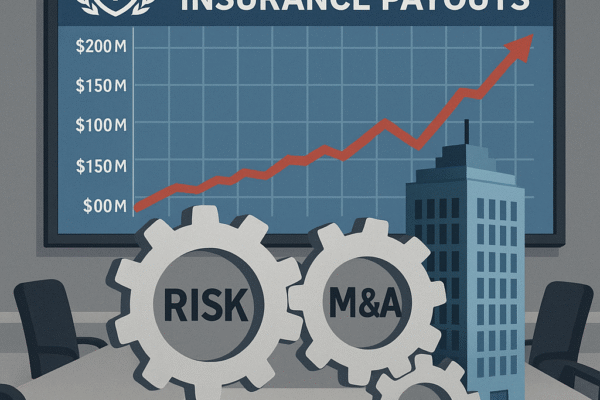As Europe undergoes its largest military buildup since the Cold War, The Carlyle Group is strategically positioning itself to capitalize on unprecedented public-private defense partnerships. The European Union’s €800 billion “ReArm Europe” initiative and €150 billion SAFE (Security Action for Europe) fund have catalyzed a fundamental market realignment, with private equity firms emerging as critical enablers of continental security objectives. This seismic shift—driven by geopolitical realignments, technological transformation, and urgent capability gaps—represents what industry analysts project could grow into a $16 trillion defense ecosystem over the coming decade. Carlyle’s established aerospace and defense practice, led by Ian Fujiyama, is deploying specialized funds and sector expertise to bridge critical infrastructure gaps while navigating complex ethical, regulatory, and labor challenges inherent in this historic rearmament cycle[3][21][32].
💼 Seasoned CorpDev / M&A / PE expertise
Europe’s Defense Spending Revolution
ReArm Europe: The €800 Billion Catalyst
The European Commission’s “Readiness 2030” white paper represents the most comprehensive defense overhaul in EU history, explicitly acknowledging that “the era of the peace dividend is long gone.” This strategic pivot responds to chronic underinvestment identified by Commission President Ursula von der Leyen, who emphasized that Europe must “invest in defence, strengthen our capabilities, and take a proactive approach to security.” The initiative’s financial architecture combines unprecedented fiscal flexibility—allowing member states to activate the Stability and Growth Pact’s escape clause for defense expenditures up to 1.5% of GDP annually—with targeted investments in critical capability gaps. The program prioritizes six transformational pillars: collaborative procurement, military mobility enhancement, AI/quantum technology adoption, Ukrainian defense integration, supply chain resilience, and strategic stockpiling[3].
SAFE: The €150 Billion Procurement Engine
Operational since May 2025, the Security Action for Europe (SAFE) regulation establishes a novel financing mechanism whereby the European Commission raises capital on public markets to fund member-state defense initiatives. SAFE’s stringent local content requirements mandate that non-EU/EEA subcontractors receive only 15-35% of contract value, with contractors required to develop replacement plans for foreign-sourced components within two years. This deliberate onshoring strategy has accelerated defense industrial base expansion across Eastern Europe, particularly in drone manufacturing and missile propulsion systems where Czech firms like PBS Group report order backlogs exceeding production capacity despite workforce constraints[1][33].
Private Equity’s Strategic Pivot
Carlyle’s Defense Practice Evolution
Under CEO Harvey Schwartz, Carlyle has transformed its aerospace and defense group into a dedicated vertical with specialized sector funds targeting mid-market suppliers in electronic warfare, space systems, and hypersonic technologies. This institutional focus reflects Schwartz’s public commentary that “defense is going to be a sector that’s going to grow secularly for a very long period of time regardless of tariffs,” positioning the firm to capitalize on what Bloomberg data identifies as $790 million in European defense deals during 2025’s first half alone. Carlyle’s operational playbook emphasizes capability bundling—consolidating fragmented component manufacturers into integrated system providers capable of competing for SAFE-funded prime contracts[18][21][32].
Competitive Landscape Dynamics
The European defense market has witnessed explosive private capital deployment, with Tikehau Capital raising an €800 million aerospace fund backed by Airbus, Safran, and Thales, while Weinberg Capital Partners closed its Eiréné fund at €215 million. This capital surge coincides with shifting Limited Partner attitudes, where traditional ESG concerns about defense investments have given way to strategic imperatives. As Weinberg’s Lionel Mestre observes, “Investor demand for defense exposure is growing, as barriers linked to ESG concerns continue to fall”—a sentiment echoed by Carlyle’s Fujiyama, who notes private equity brings “essential capital and expertise” to complement constrained government budgets[21][32].
Public-Private Partnership Mechanisms
SAFE Implementation Frameworks
The EU’s partnership architecture enables three primary collaboration models: joint venture formations between primes and financial sponsors, special-purpose acquisition vehicles for capability-specific projects, and long-term concession agreements for infrastructure modernization. Canada’s June 2025 security pact exemplifies this trend, with Prime Minister Mark Carney announcing negotiations for “Canada’s access to the joint military procurement instrument we call SAFE,” signaling non-EU states’ integration into the defense industrial ecosystem. These frameworks allow firms like Carlyle to deploy capital against predictable revenue streams while mitigating technology transfer risks through structured IP controls[5][27].
Labor Market Transformation
Europe’s defense expansion faces severe human capital constraints, with Reuters reporting a projected 760,000 skilled worker shortage to meet NATO’s 3% GDP defense spending target. This deficit spans AI engineering, advanced welding, and quantum computing roles, prompting Carlyle portfolio companies to implement “triple-jump” compensation packages that poach talent from automotive and aerospace sectors. The labor crunch has accelerated automation investments, with Czech missile engine manufacturer PBS Group reporting that staffing limitations cap production growth despite order books exceeding €2 billion[33].
Sector-Specific Investment Strategies
Next-Generation Capability Platforms
Carlyle’s targeting prioritizes five capability domains: autonomous swarm systems, cyber-electronic warfare integration, multi-domain command architectures, hypersonic countermeasures, and quantum-resistant communications. This focus aligns with the EU’s identified critical gaps and leverages the firm’s historical strengths in government services investing. Portfolio companies like German sensor specialist Hensoldt have secured SAFE co-funding for AI-enabled threat detection systems, demonstrating the program’s viability for private equity-backed technology development[3][21].
Supply Chain Consolidation
Fragmented European defense suppliers present consolidation opportunities, with firms like Cobham Satcom and Survitec’s aerospace division attracting private equity interest. Carlyle’s “industrial mosaic” strategy aggregates complementary SMEs into vertically integrated suppliers capable of competing for major subsystem contracts. This approach mitigates supply chain vulnerabilities exposed by Ukraine conflict, where single-source dependencies caused critical munitions shortages. The EU’s requirement for dual-source contracting further incentivizes platform-building through M&A[21][32].
Geopolitical and Regulatory Considerations
Expanding the Trusted Partner Ecosystem
The EU is actively broadening defense cooperation beyond traditional NATO parameters, signing security pacts with Canada while advancing talks with India and the UK. These agreements create export pathways for Carlyle-backed technologies, though they introduce complex regulatory layering. For instance, Canada’s participation in SAFE procurement requires harmonization of export controls between Ottawa, Brussels, and member states—a process managed through Carlyle’s dedicated compliance practice that navigates International Traffic in Arms Regulations (ITAR) and Dual-Use Goods frameworks[1][5].
Political Risk Mitigation
Heightened scrutiny of foreign ownership in strategic assets presents both challenge and opportunity. Bain Capital’s exploration of Chemring Group attracted political attention, while Carlyle avoids such exposure through controlled subsidiary structures and domestic management retention. The firm’s government affairs team actively shapes procurement policies through the Aerospace, Defence and Security Association, advocating for “strategic investor” classifications that facilitate cross-border transactions without national security objections[32].
Financial Architecture and Exit Pathways
Structured Capital Solutions
Carlyle deploys bespoke financing instruments for defense investments, including SAFE-aligned co-investment vehicles, royalty-based technology licensing models, and infrastructure-style yieldcos for ammunition plant investments. The €150 billion SAFE fund’s first-loss tranche structure enables senior debt financing at sub-5% rates for qualified projects, dramatically improving equity returns. These arrangements typically feature 7-12 year horizons with extension options aligned with defense program lifecycles[1][3].
Liquidity Event Evolution
Traditional defense sector exits through strategic sales face political constraints, driving innovation in public market pathways. Carlyle’s 2024 IPO of Japanese x-ray specialist Raku—the largest PE-backed listing in Japan’s history—demonstrates viable public market receptiveness. Secondary transactions to sovereign wealth funds have accelerated, with UAE and Saudi funds paying 14-18x EBITDA for European defense assets. The emergence of dedicated defense SPACs creates additional liquidity options, with three such vehicles raising aggregate €2.1 billion in 2025’s first quarter[18][21].
Conclusion: The New Defense Investment Paradigm
Europe’s defense transformation represents a generational investment opportunity, with Carlyle positioned at the convergence of geopolitical necessity, technological disruption, and financial innovation. The firm’s integrated approach—combining sector-specific funds, operational expertise, and structured public-private partnerships—creates asymmetric advantages in capturing value from the €800 billion ReArm Europe initiative and its projected $16 trillion downstream ecosystem. As defense spending shifts from cyclical expense to strategic imperative, Carlyle’s model offers a blueprint for institutional capital deployment that balances financial returns with continental security objectives. The coming decade will likely witness further institutionalization of defense investing, with permanent capital vehicles and listed defense yieldcos becoming mainstream portfolio allocations[3][18][21][32].
Sources
https://www.globalpolicywatch.com/2025/06/launching-150-billion-euro-for-defense-and-technology/, https://www.marketscreener.com/quote/stock/THE-CARLYLE-GROUP-INC-10531255/news/Deal-hungry-equity-investors-eye-Europe-s-potential-defence-industry-boom-50158436/, https://ec.europa.eu/commission/presscorner/api/files/document/print/en/ip_25_793/IP_25_793_EN.pdf, https://www.youtube.com/watch?v=pRQUj9TAZ1I, https://www.youtube.com/watch?v=fwhPJaTUHi8, https://en.wikipedia.org/wiki/Columbia_Business_School, https://pgainllc.com/wp-content/uploads/2018/05/2017.pdf, https://pgainllc.com/wp-content/uploads/2018/05/2012.pdf, https://guidelyassets.s3.ap-south-1.amazonaws.com/pdf/162819098835.pdf, https://www.scribd.com/document/511849432/Financial-Times-Europe-31-08-2019-01-09-2019, https://pgainllc.com/wp-content/uploads/2018/05/2017.pdf, https://pgainllc.com/wp-content/uploads/2018/05/2012.pdf, https://guidelyassets.s3.ap-south-1.amazonaws.com/pdf/162819098835.pdf, https://www.scribd.com/document/511849432/Financial-Times-Europe-31-08-2019-01-09-2019, https://www.youtube.com/watch?v=fwhPJaTUHi8, https://surs.org/wp-content/uploads/2023_Sept07_Inv.pdf, https://apps.dtic.mil/sti/tr/pdf/ADA518649.pdf, https://www.youtube.com/watch?v=CHKBMI7ACKU, https://pgainllc.com/wp-content/uploads/2018/05/2012.pdf, https://pgainllc.com/wp-content/uploads/2018/05/2017.pdf, https://pe-insights.com/private-equity-firms-ramp-up-european-defence-investments-amid-historic-rearmament-surge/, https://guidelyassets.s3.ap-south-1.amazonaws.com/pdf/162819098835.pdf, https://pgainllc.com/wp-content/uploads/2018/05/2012.pdf, https://www.scribd.com/document/511849432/Financial-Times-Europe-31-08-2019-01-09-2019, https://apps.dtic.mil/sti/tr/pdf/ADA411136.pdf, https://www.chinafile.com/contributors/o, https://www.youtube.com/watch?v=fwhPJaTUHi8, https://www.globalplayer.com/podcasts/42L18v/, https://en.wikipedia.org/wiki/Jerome_Powell, https://dlcp.dc.gov/sites/default/files/dc/sites/DLCP/publication/attachments/2023%20Businesses%20with%20Reports%20Due_0.pdf, https://www.indeed.com/q-company:%22the-carlyle-group%22-jobs.html, https://pe-insights.com/private-equity-firms-ramp-up-european-defence-investments-amid-historic-rearmament-surge/, https://www.youtube.com/watch?v=pRQUj9TAZ1I, https://www.tandfonline.com/doi/full/10.1080/10509585.2024.2344885, https://www.policyarchive.org/download/11851





